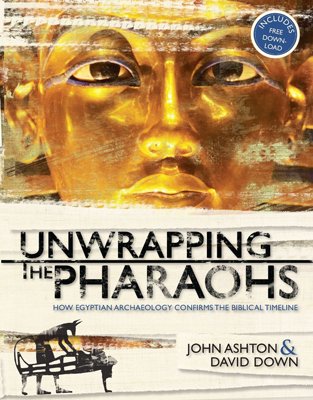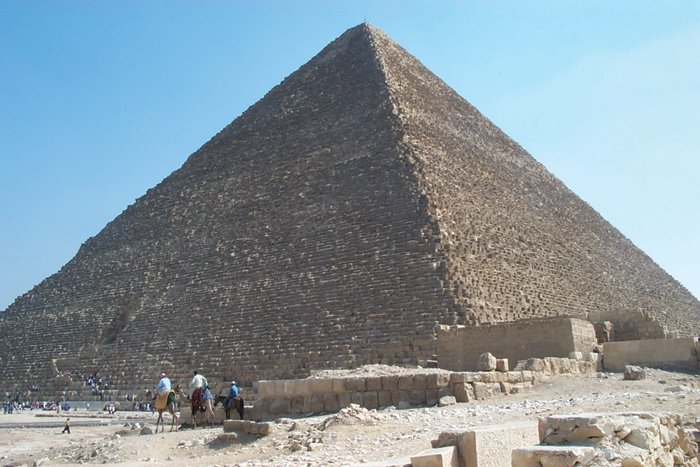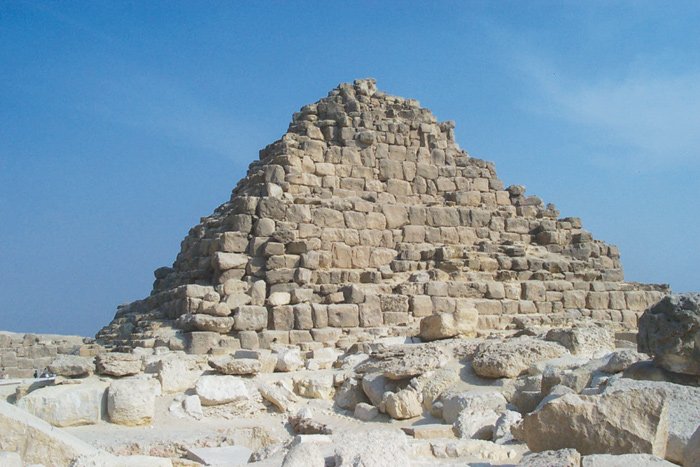
Chapter 5
Khufu Built the Big One
Seneferu was succeeded by his son Khufu, known to the Greeks as Cheops (pronounced Kee-ops), and he built the biggest pyramid of them all. It is 751 feet (229 m) at the base and originally stood 479 feet (146 m) high. Stone robbers have taken stones from the top, leaving it only 446 feet (136 m) high today. So many tourists fell to their deaths or were badly injured attempting to climb the pyramid that today climbing is forbidden.

The northwest corner of the Great Pyramid of Khufu, showing some of the huge blocks of stone, weighing up to 15 tons each, that went into the building.
The work of building this pyramid must have started by leveling the stone base from corner to corner. It appears that there was a natural rise or hump in the middle which was not removed and leveled. Perhaps this was left so that there would be fewer blocks to fit into place. Each of the lower blocks measures about a cube of 3.28 feet (1 m) and weighs approximately 2.5 tons each. Had there not been the hump, the lowest layer would have required over 50,000 heavy squared blocks which came from the limestone quarry less than 0.6 miles (1 km) to the south.
How the building of the pyramid was accomplished and how many workmen were involved is still a matter of conjecture and admiration. Herodotus stated, “The work went on in three-monthly shifts, a hundred thousand men in a shift. It took ten years of this oppressive slave labour to build the track along which the blocks were hauled—a work in my opinion of hardly less magnitude than the pyramid itself, for it is five furlongs in length. . . . To build the pyramid itself took 20 years.”1
Herodotus cannot be regarded as an authority on the matter. He arrived at the scene many centuries after it was all over and was dependent on what the local priests told him, and there is no guarantee that they had it right.
More recent evidence comes from the discovery of a bakery by Mark Lehner south of the pyramid, which he estimated would have been capable of producing enough bread to feed 20,000 men each day. Even that is a lot of people. The problem would have not only been finding such a large work force, but organizing them so that they were not all walking on each other’s toes.

A rebuilt oven replicating hundreds of ovens that could have baked bread for the 20,000 plus workmen involved in building the pyramid.
As far as we know, the wheel was not used in Egypt at that time, so Herodotus would have been correct in saying that the blocks were hauled from the quarry to the site. A large number of masons could have worked in the quarry chopping out the stones and roughly squaring them. Examination of the stones visible in the pyramid today reveals that the stones in each layer were carefully trimmed to the same height, but the length and breadth of each stone was rather irregular. It was up to the on-site foremen to fit them into matching places. Lime plaster was poured between many of the blocks to steady them. This debunks the nonsense about all the blocks being poured from liquid lime.
Fitting the lower courses into position would have been relatively simple and fast. They could have been dragged into position from all four sides, but once the edifice rose to a higher level the problems began. Herodotus wrote, “The method employed was to build it in steps, or as some call them, tiers or terraces. When the base was complete, the blocks for the first tier above it were lifted from ground level by contrivances made of short timbers. On this first tier there was another which raised the blocks a stage higher, then yet another which raised them higher still. Each tier or storey had its set of levers.”2

Section of the quarry at Aswan, 450 miles (720 km) south of the pyramid, from which came the huge 30-ton granite blocks used in Khufu’s burial chamber.
All very well, but we do not know what sort of levers could raise the larger 15-ton blocks into place. A few years ago, some Japanese engineers claimed that they had made some successful levers that could raise blocks of stone weighing two tons, but that did not solve the problem of the 15-ton blocks.
The popular theory is that a ramp was built, up which the stones were dragged. Some suggest that a ramp could have wound in an ascending spiral around the pyramid. At the Temple of Karnak there is a pylon or gateway which has some huge blocks of stone. It is apparent that these were dragged up a ramp made of sun-dried mud bricks because not all the bricks were removed after the job was completed. They are still there to verify the method used, but the length of a ramp to reach the height of the great pyramid of Khufu has been calculated to be in the order of 0.6 miles (1 km) or more. The amount of material needed for such a ramp is staggering, and the question of where all this material went is hard to answer.
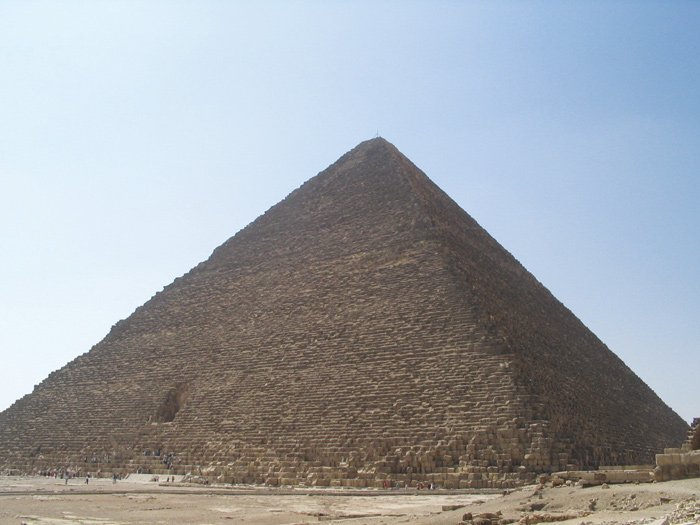
The north side of Khufu’s pyramid. A recent estimate claims that nearly 3 million blocks of stone were used to build this pyramid.
The construction of the pyramid was extraordinarily precise. It is precisely level and exactly square with no more than 8 inches (20 cm) difference in length between the sides of the pyramid. The sides are aligned true north, south, east, and west, indicating an advanced knowledge of astronomy and surveying.
The dimensions and geometry of the pyramid are such that if a vertical circle is imagined whose center is the top of the pyramid and radius is the height of the pyramid, the circumference of that circle is exactly the circumference of the base of the pyramid; that is, the sum of the length of the four sides at the base. This feature suggests knowledge of the value of pi, centuries ahead of the Greeks.
The pyramid contains an estimated 2.3 million blocks of stone averaging 2.5 tons in weight each, with the biggest stone weighing a massive 15 tons. We do not know for sure how long it took to build the pyramids. If we accept Herodotus’ report that Cheops’ pyramid took 20 years to build, we can calculate the rate at which the construction stones were put in place. If we assume that the Egyptian builders worked 12 hours per day continuously for 20 years, the 2.3 million blocks would require 26.3 stones to be put in place each hour, or just over 2 minutes to place each block, averaging 2.5 tons accurately in place, many feet above the ground. This feat is truly amazing even by today’s construction standards and suggests a very highly developed knowledge of engineering. If we accept a shorter time period of just two years, in line with the dates given in the Bent Pyramid, we require that one of these huge stones was precisely placed every 13.5 seconds.
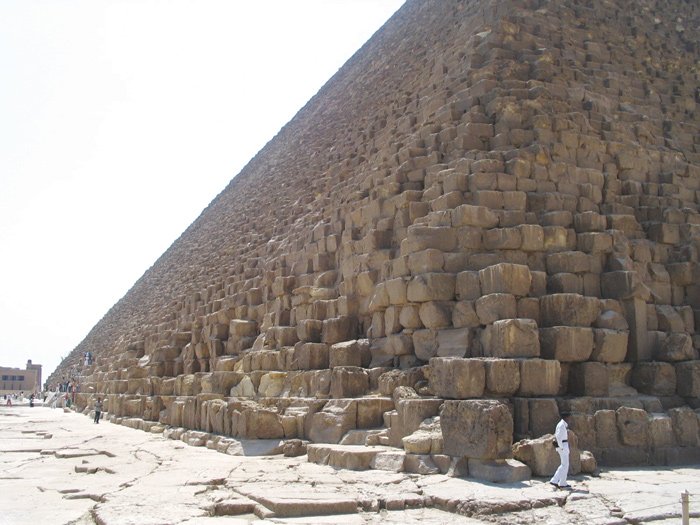
If you can obtain permission to climb to the top of Khufu’s pyramid, this is the corner to make your climb.
All this has led to wild speculation about how the pyramids were built, such as the involvement of UFOs etc., but there is no inscriptional or archaeological evidence to support these speculations, which leaves us with the conclusion that we do not know for sure just how this gigantic feat was accomplished. With all our modern inventions and machines, it would still be a challenge to any civil engineer to build such a pyramid today. Instead, we are left to marvel at the ingenuity, craftsmanship, and organizing skill of this wonderful people who lived so long ago. They were certainly not primitive cave men, but rather were highly intelligent and cultured people.
The man who supervised this giant project was Khufu’s nephew, Hemiunu. His statue was found in a chamber of his tomb. It is a magnificent life-sized statue, and depicts him as a solidly built fellow with a copious bosom befitting his rank. Tomb robbers had broken into the tomb at an early date and severed the head and smashed it to retrieve the inlaid eyes. However, archaeologists carefully gathered the pieces, enabling the statue to be restored.
The entrance to this pyramid is on the north side above ground level and it is 26 feet (8 m) off center. This was obviously not due to a miscalculation by the builders. Rather, it was undoubtedly a subtle attempt to thwart the inevitable tomb robbers. They would naturally start their illicit digging from the center, and that is what they did.
The entrance used by tourists today is a devious tunnel which was cut through the stones and finally connected with the ascending passage. The man responsible for this entrance, which was constructed about 1,100 years ago, was a Turkish governor called Mamun, who was apparently hoping to find treasures in the tomb chamber. However, we do not know if he was successful or not.
As the original pyramid builders anticipated, Mamun’s men started digging through the center of the pyramid and might have gone clean through it and out the other side without finding anything, except for a piece of luck. It appears that as the workmen hammered away with their picks they dislodged the stone which sealed the entrance to the ascending passage. Its crash to the floor of the access tunnel alerted them to the presence of this passage, and they changed direction to link up with this ascending passage and thence into the body of the pyramid.
The entire structure of the pyramid was finally clad with huge blocks of shining white Tura limestone brought from the Maqqatam Quarry, 7.5 miles (12 km) across the other side of the Nile. These blocks had to be dragged to the river, floated across, and hauled to the building site. Most of these stones have been stripped off by local builders in the not-too-distant past, leaving the inner stones exposed.
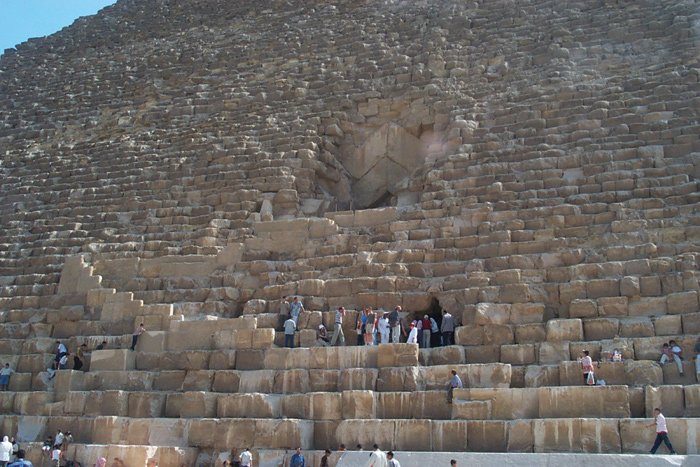
The entrance used by tourists today is beneath this. It was made by Caliph Mamun 1,100 years ago in an attempt to reach the treasures he hoped he would find inside.
From the true entrance, a passage descends into bedrock to a tomb chamber which was never completed. It was unlikely to have been intended as the final resting place of the king, because it was not even within the pyramid they took so much trouble to build. It was more likely a blind to fool tomb robbers into thinking that there was nothing of value to be stolen.
Deviating from the roof of this descending passage was an ascending passage. It was plugged with huge blocks of stone which had been slid down from above to prevent anyone entering. At the same time, it would not have been easily visible to anyone going down the descending passage. Halfway to the tomb chamber, this passage opens out into an ascending gallery which has corbeled walls. Each layer of stone was placed a little farther inward to reduce the span of stones on the ceiling of this gallery, an ingenious device.
Where the ascending passage meets the gallery, a horizontal passage branches off to the center of the pyramid to what has become known as the “Queen’s Tomb Chamber.” There is no evidence to support the idea that the queen was to have been buried here. It was more likely to have been for the installation of a statue of a god, or of the king himself. This tomb chamber also was left unfinished.
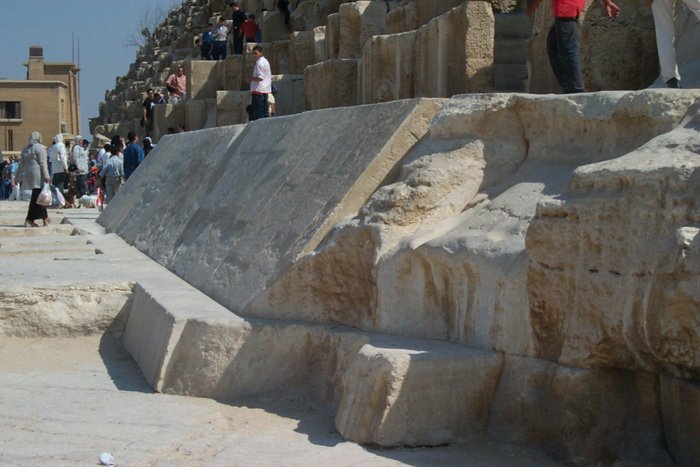
Some of the huge white Tura limestone facing stones are still in place at the bottom of the pyramid. They survived because they were buried under the sand when the stone robbers took the upper facing stones.
From the side walls of this chamber, two small passages penetrate the pyramid but do not reach the outside of the pyramid, and their purpose is not known. In 1993, Dr. Rudolph Gantenbrink, an expert in robots, was given permission to send a small robot up the 7.8-inch (200 mm) square left-hand passage to investigate it. The robot was fitted with a miniature camera which transmitted pictures back to the scientists. Gantenbrink claimed that this camera revealed that there was a portcullis stone door (one that slides up and down rather than swinging open) at the top of the passage, and in this door were two copper handles. In 2002, pyramid researchers were given permission to drill through this door and insert a miniature camera only to find another stone door or plug a few hundred millimeters behind it. At the time of writing, these tunnels still have not been explored or their purpose in the structure of the pyramid understood.
Also at the junction of the ascending passage and the ascending gallery there is a rough shaft that goes down to join the top of the descending gallery. Apparently, after the king had been buried in his tomb chamber, workmen slid some huge blocks of stone down the ascending passage to block any future entrance from the descending passage, but that would have left them entombed in the pyramid. This rough passage would have enabled them to make their escape.

Still piled up against the first pylon of the temple of Karnak are some of the mud bricks that formed the ramp up which the blocks of stone were dragged. A similar ramp may have been made to haul the stones to the top of Khufu’s pyramid.
At the top of the ascending gallery, a low passage enters the king’s tomb chamber. The huge granite blocks lining this chamber weigh up to 30 tons each and are so perfectly squared and fitted together that it has been estimated that there is only an average gap of half a millimeter between them. We can only marvel at the skill of the masons who achieved this perfection with the copper and stone tools available to them.
Above this chamber are five ceilings of granite blocks, one above the other, with cavities in between. A workman had scribbled Khufu’s name in one of these cavities. The top one has a gable roof to divert the enormous weight of the stones above it. All of the slabs of granite forming the immediate ceiling of the tomb chamber are cracked, but there seems to be no danger of collapse.
At the end of this tomb chamber is a sarcophagus which is empty. It has been broken on one corner, possibly when thieves prized off the lid, which is missing. This sarcophagus must have been installed there as the pyramid was being built because it is slightly higher than the opening from the ascending gallery into the tomb chamber.
Two small passages were also made in the sides of this tomb chamber, and they go right to the outside of the pyramid. They are too small for anyone to climb through and too insignificant to allow fresh air to enter the chamber. They most likely had ritualistic significance for allowing the king’s ba to leave the tomb chamber each morning and return at sunset.
Whatever the original idea, one of these so-called vents now serves a very useful purpose. The thousands of tourists milling through the pyramid each day used to make the air insufferable. However, now an electric exhaust fan has been installed in the south vent, pumping out the bad air and sucking fresh air into the passages and tomb chamber.
Besides these three tomb chambers already described, there seem to be other cavities. In 1986, French scientists used stone scanning equipment on the pyramid and discovered three gaps beyond the west wall of the passage leading to the “Queen’s Tomb Chamber.” They drilled three holes through the wall of the passage and broke into a cavity filled with sand. Beyond that was more stone and then the cavity their scanning equipment had found. It was about 10 feet (3 m) long, 6.5 feet (2 m) wide, and 6.5 feet (2 m) high. A TV lens was inserted and the breathless scientists waited for an image to show up. Who knew what fabulous treasure might be hidden within. However, the monitor picture finally showed that the cavity was completely empty. The mystery of the empty chambers is still puzzling scientists.

The ascending corridor is 129 feet (39 m) long and only a little over 42 inches high (1 m) which makes ascending it in a crouching posture a back-bending exercise.
The solution may lie in the construction method for the pyramid. The builders may have saved themselves some stone by leaving gaps bridged by larger stones, or cavities filled with sand, which would be simpler to provide than stone. Who knows how many other such laborsaving devices may be scattered through this huge monument.
On the east side of Khufu’s pyramid was a mortuary temple with a causeway down to the valley. The causeway has now gone and so has most of the temple. Only the black basalt floor remains.
The only statue of Khufu that has ever been found was a small ivory statue that came to light at Abydos. Sir Flinders Petrie was excavating there when his men found the body of this statue. Never one to give up easily, Petrie set his men to work sieving for the small head he felt sure must be there somewhere. It took three weeks of arduous work until the coveted head was found. The reassembled statue is now in the Cairo Museum.
On the east side of the great pyramid are three smaller pyramids. There are no inscriptions in them to identify their owners, but it is usually assumed that the two southern ones belong to Khufu’s queens, Meritites and Henutsen. Some scholars feel that the third one may have been for his mother Hetepheres because her burial shaft is just to the north of this pyramid, but it would be rather strange for her to have a pyramid and a burial shaft at a distance from the pyramid.

South of Khufu’s pyramid is a portion of the wall that surrounded the pyramid enclosure. The gateway, known as the “Gate of the Crow” (for some unknown reason), is spanned by a huge granite block.
There is more than one mystery connected with the burial of Hetepheres. It would be reasonable to suppose that she would have been buried with her husband, Seneferu, at Dahshur, but in 1925 George Reisner’s photographer was setting up his camera on the east side of the pyramid when he uncovered a patch of plaster under the sand. When the plaster was removed, they found steps leading down into a burial shaft. The shaft was filled with blocks of stone set in plaster, indicating that the tomb beneath must have been undisturbed. Eighty-two feet (25m) down they found stone blocks plastered together.
Under this course of masonry they found a tomb chamber filled with fabulous treasures, one of which bore the name of Hetepheres. It took many months to remove, preserve, and catalogue all these valuables, but at last, on March 3, 1927, the dramatic moment came when they opened the sarcophagus. As the lid rose, those present eagerly leaned forward for their first glimpse of the golden coffin they expected to find beneath. There was a gasp of surprise when they realized that the sarcophagus was empty.
Why had all these funeral treasures been carefully buried when there was no body? That question has never been satisfactorily answered. Reisner speculated that Hetepheres had originally been buried at Dahshur, but when grave robbers started their depredations, Khufu had given orders for his mother to be reburied near his great pyramid. Perhaps the body had already been stolen, and the officials, fearing to inform the king of the tragedy, had gone ahead with the burial anyway. Rather unlikely, but what is the alternative explanation? Mark Lehner suggested that it had been reburied in the nearby pyramid when it was built, but perhaps we will never know the answer for sure.

Near the northeast corner of Khufu’s pyramid was a mortuary temple. Only the black basalt floor remains.
The Egyptian belief in the afterlife required a funeral boat to be buried with the deceased. It is not certain what function this boat was supposed to perform. Perhaps it was a solar boat to take the ba to the heavenly abode. Perhaps it was to ferry the ba in joy rides up the Nile, or perhaps to take it to the sacred city of Abydos. Most Pharaohs were content to have miniature boats, but Khufu, who always did things on a grand scale, had six huge boats associated with his pyramid.
There is a boat pit about 144 feet (44 m) in length on the southeast side of his pyramid. It is in the shape of a boat and undoubtedly there was an assembled boat buried there. It has long since disappeared, probably taken for firewood by local peasants thousands of years ago.
There are two smaller boat pits of similar shape next to the so-called queens’ pyramids. These pits also are empty, their funeral boats having suffered the same fate as Khufu’s large boat.
In 1954, a spectacular discovery was made. South of the pyramid were huge heaps of rubble 65 feet (20 m) high that had been left there by archaeologists who had been excavating the surrounding area. They thought that the flat area beside the pyramid would be a suitable place to dump the rubble. It was decided to clear the area, and so the work was begun under Kamal el-Malakh. When the workmen got down to the level of the pavement made of stone blocks 1.5 feet (0.5 m) thick, they uncovered the foundations of a wall which had originally been 6.5 feet (2m) high encircling the pyramid. But Malakh noticed that the wall on this side of the pyramid was closer to the pyramid than it was on the other three sides, and he suspected that it may have been deliberately placed there to hide something.
With a sharp stick he started probing the pavement. Sure enough, he exposed some pink lime mortar that seemed to outline the shape of a pit, and he ordered the paving blocks to be removed. This was no easy task. The blocks were securely fixed in place with mortar, and had to be chiseled apart. Knowing there might be some priceless treasure beneath, great care had to be exercised lest a heavy block collapse into the pit, destroying the contents.
On May 26, the work was begun, and when it became possible to peer into the pit, Kamal was excited to find that it contained the components of a complete funeral boat. Even the wood and the ropes were in remarkably good condition after being buried for thousands of years.
Then followed the even more exacting task of removing the ancient items. There were 651 separate pieces, and the amazing thing was that, although there were no missing members, the boat was not assembled, but stacked and tied in neat bundles. The beams of the ship were of cedars of Lebanon and were up to 75 feet (23 m) in length, and the ship when reassembled would be 148 feet (45 m) long. It was the oldest, largest, and best-preserved ancient boat ever discovered. The last item was removed from the pit in late June 1957.

The recently discovered cemetery where officials who supervised the building of the pyramid were buried.
The task of reassembling such an ancient ship of unknown shape and design was obviously not going to be easy. The job was assigned to Ahmed Moustafa, the Cairo Museum’s official restorer.
Moustafa took pride in his work, and was meticulous in his approach. He first studied all the known tomb paintings and reliefs for clues as to the nature of early boats, and then made scale models 1:10 of every item taken out of the pit. He then experimented with assembling the model ship until he was satisfied that he was following the original plan. Only then did he try assembling the actual boat. At last, in 1974, the boat stood proudly in its original glory.
It was a remarkable piece of workmanship by any standard. Apart from a few copper staples, the whole craft consisted of wood lashed together by rope, but so expertly that when immersed in water, the beams would swell to make the craft watertight. There were five pairs of oars up to 26 feet (8m) long, and when it is considered that all this work was done before the invention of pulleys, block and tackle, or even wheels, we are obliged to acknowledge the skill and intelligence of these ancient artisans. Actually, Herodotus had described in great detail how the Egyptians had made their boats. It was found that his account, written 2,500 years ago, corresponded very exactly with what was found in the pit.

One of the four pits where funerary boats were buried. This boat and its companion on the east side of the pyramid were buried intact.
The intriguing question that has engaged archaeologists is the original purpose of this craft. It is speculated that the Egyptians had a concept of the ba of the king being ferried across the water to the future life, or up and down the Nile; of a ship required by the sun god to traverse sky and land, but all these theories seem inadequate to explain why the ship was not assembled. Even if it only had ceremonial significance, one would think that an assembled ship would be needed to fulfill even a ceremonial concept.
Perhaps the answer is to be found in the observation by Moustafa that some of the beams display marks of ropes, suggesting that the ship had been assembled, and perhaps used just once, and then dismantled and buried. Possibly this was the craft used to ferry the king’s mummy from the palace at Memphis, 19 miles (30 km) to the south, to the site of the burial, and then the ship was buried in the area in much the same way as we may place flowers on a grave. It was known at the time of the original discovery that there was another pit next to the first pit. This other pit was opened in October 1990 and is in the process of being exhumed, but why two boats side by side?
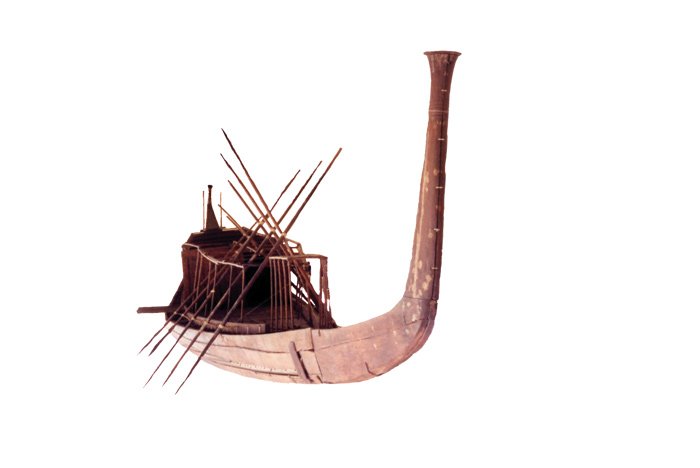
There were two funerary boats interred on the south side of the pyramid. This boat consisting of 1,224 individual pieces, many neatly bundled together, was expertly reassembled by Ahmed Moustafa in 1968.
Five boats had been accounted for, but in 1984 another came to light. Authorities were concerned at the erosion of the monuments in Egypt, and atmospheric pollution was a likely cause, so it was decided to reduce traffic near the pyramid by demolishing the road that ran between Khufu’s pyramid and the queens’ pyramids. When that was done, another large boat pit was exposed, making six altogether.
To the southeast of the big pyramid is a massive stone wall. The gateway through this wall has some huge stone slabs, 26 feet (8 m) in length, spanning overhead. Passing through this gateway is a path that leads to some recently discovered tombs. They turned out to be the graves of some of the officers who supervised the building of the pyramids at Giza. The Egyptian Archaeological Mission found some 20 tombs belonging to the men who worked on building the great pyramids of Giza. The tombs were made of sun-dried mud bricks. Inside the tombs they found a number of pottery objects and six skeletons dating back to the 4th Dynasty, in which the great pyramids were built.
Dr. Zahi Hawass, director of the Giza Antiquities, said that the tombs were of a special architectural style. The skeletons had been analyzed, and some of them had been surgically operated on. Apparently, the operations on the feet had been successful, as the bones had recovered from the operation. One tomb was surmounted by a miniature pyramid. This was significant, as it was previously thought that pyramids were the sole prerogative of the pharaohs. However, this pyramid seems to have been sanctioned by the king.

On the south side of Khufu’s pyramid is the air-conditioned museum in which the re-assembled boat is on display.
There are differences of opinion about how long Khufu reigned. Some say 21 years, others 41 years. According to Herodotus, “Cheops (to continue the account which the priests gave me) brought the country into all sorts of misery. He closed the temples, then, not content with excluding his subjects from the practice of their religion, compelled them without exception to labour as slaves for his own advantage.”3
This report need not be taken too seriously. It was only what the priests told him centuries after Khufu lived, and who can say whether they were telling the truth as they believed it or whether they were deliberately trying to mislead this intruder into their country? All we can say is that Herodotus was a good journalist. He simply reported what was told to him. Whether he believed it or not is not the point. We can certainly doubt the veracity of his next statement.
He continues, “No crime was too great for Cheops. When he was short of money, he sent his daughter to a bawdyhouse with instructions to charge a certain sum—they did not tell me how much. This she actually did, adding to it a further transaction of her own; for with the intention of leaving something to be remembered by after her death, she asked each of her customers to give her a block of stone, and of these stones (the story goes) was built the middle pyramid of the three which stand in front of the great pyramid.”4
Nobody in their right mind could conceive of a king of Egypt selling off his daughter like that, no matter how unscrupulous he was. So how accurate is this story that the priests told Herodotus?
These stories surrounding Great Pyramid of Khufu epitomize the mysteries and difficulties facing archaeologists and historians who try to piece together the history of the pyramids and their ancient builders.
Unwrapping the Pharaohs
Adults and children alike are fascinated by Egyptian civilization. But most modern archaeologists have lately tried to use Egyptian chronology to dispute the biblical record. Secular textbooks and videos challenge the faith of students and discredit the biblical account of Exodus. Those who wish to defend the accuracy of the Bible now have an incredible tool in this exciting book that provides compelling confirmation of the biblical account.
Read Online Buy BookFootnotes
- Herodotus, The Histories, p. 178.
- Ibid., p. 179.
- Ibid., p. 178.
- Ibid., p. 179.
Recommended Resources

Answers in Genesis is an apologetics ministry, dedicated to helping Christians defend their faith and proclaim the good news of Jesus Christ.
- Customer Service 800.778.3390
- Available Monday–Friday | 9 AM–5 PM ET
- © 2025 Answers in Genesis

